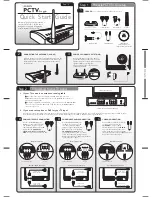
MFJ-989D VersaTuner V
Instruction Manual
9
Always check the position of the Antenna Selector before applying RF power!
If you fail to do so, you
may accidentally dump 1500 Watts into the 300-Watt dummy load with catastrophic results or find
yourself trying to adjust the tuner's controls while the network is bypassed! Also, never rotate the
Antenna Selector when RF power is being applied! "Hot switching" will cause severe arcing and
burning of the switch contacts -- and the sudden load interruption could damage your transmitter.
Important Warning: When operating your tuner, always check the position of the Antenna Selector
before applying RF power. Also, never change the Antenna Selector when RF power is applied!
Dummy Load
The tuner's internal dummy load features a precision non-inductive power resistor that maintains low
SWR across the entire HF spectrum. The load performs two important functions:
1.) Normalizing Transmitters To 50-Ohms:
Use the load to pre-tune older transceivers or vintage
transmitters with tube-type PA amplifiers to normalize them for 50-Ohm output prior to routing through
the T-network.
2.) Accurately Measuring Transmitter Power:
Use the load to check any radio running 300 Watts or less
for true peak-power power or average power output through the tuner's precision wattmeter.
The
Dummy Load
resistor is convection cooled through the bottom of the cabinet and is rated to safely
dissipate 300-Watts of applied RF for up to 30-seconds at a time. The minimum cool-down period
between power applications is specified at 2-minutes. Longer tune-up durations are possible at lower
power levels, but the continuous-duty power rating of the resistor is 25 Watts, so you must adjust the
key-down time accordingly.
Never apply power levels exceeding 300-Watts for even short durations.
Doing so could permanently
alter the resistor's value or catastrophically destroy it. Heat damage to other tuner components could
result, as well!
Important Warning: Never tune a high-power linear amplifier into the MFJ-989D Dummy Load or
permanent damage will result!
1:1 Balun
A built-in Guanella-style current balun is used to transition from the tuner's unbalanced
Wire
terminal to
the
Bal. Line
output. The balun is wound on two massive 2.4-inch toroid cores with heavy polyethylene-
dielectric wire to ensure a high breakdown voltage for handling difficult high-impedance loads.
Windings are terminated to ceramic terminal posts mounted on the back panel, with a fourth lead
permanently grounded to the chassis (see diagram next page):






































